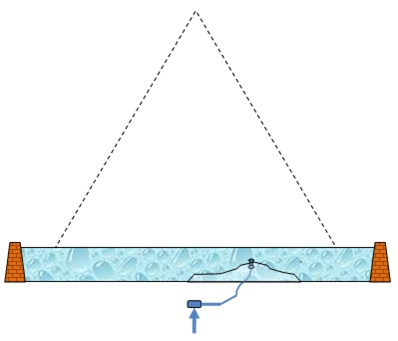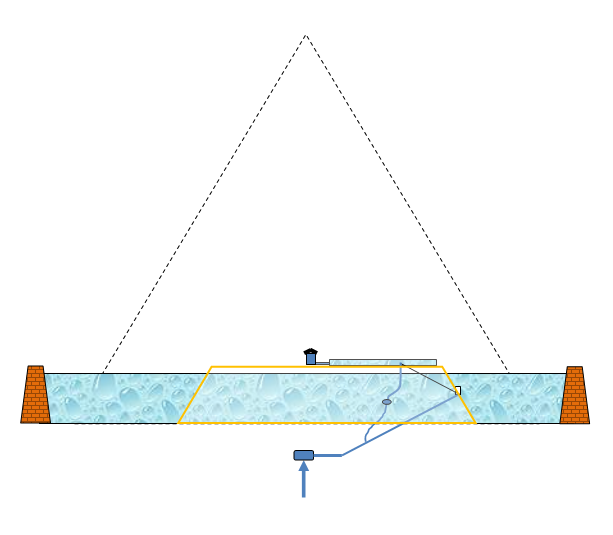This is an alternative view of the construction of Cheops from The Great Pyramid Rainmaker. It is based on knowledge of how Cheops worked and its purpose as opposed to the third person account related by Herodotus. No researcher has been able to make sense of the currently accepted time frame for good reason, it is wrong.
‘Cheops was built in twenty years’ is repeated so often that it is rarely questioned. It had to have been constructed in a single lifetime in order to fit the tomb view. Scholars try to explain the pyramid with this in mind and invariably fail. This summary highlights the various working stages of the build and the value to the builders. It implies that the structure was probably constructed over many generations.
Several engineers and archaeologists have found evidence of water in and around the Great Pyramid. Here the implications for the building program and the functions are covered briefly. There are five phases outlined, though the pyramid could have received more than one refurbishment between any of the key stages. Each is deduced from the mechanic of the pyramid itself and data that is often overlooked in order to maintain the tomb view.
The five functional phases of Cheops
- A reservoir that allowed the site to be settled
- A mastaba/valve that increased the amount of water stored
- A geyser chamber that sent water to the summit of a flat top pyramid
- A higher chamber and pyramid that processed water & produced rain
- A cenotaph built over a failed machine
Each stage is summarized below. The evidence lies housed within the structure. It is a matter of showing how each phase worked under simple principles. The working machines were all neatly buried beneath tons of geometric rocks in the final phase. Despite the discovery of moving parts, water and a common scheme, Cheops is a tomb to the scholars. No matter what is found, there will always be an academic willing to find some new esoteric reason for it. There will no doubt also be a mystic and alternative writer to do the same.
Here the focus is on how to get the various parts working and what they meant for the builders. Importantly the science of each stage is known and was known to the ancient Egyptians. The various phases were break points where the utility could be exploited for decades before embarking on the next. There is a brief account of each step below. Hopefully it is enough to convince the open minded that Cheops was built over centuries and performed vital functions for long intervals. For a more detailed description read The Great Pyramid Rainmaker.
The Reservoir
The plateau was inhabited long before the pyramids were even conceived. It made a fine refuge from the flooding of the Nile, because of its height and the free flowing ground water. A cold water geyser system functioned where Cheops was eventually to be built. Its sediment raised the natural mound that is still at the core of Cheops.
At this early stage there were no plans for a pyramid, just a need to capture the ground water and store it. The reservoir would allow large numbers of people to permanently settle the site instead of retreating as the water table dropped. To store the water the first settler-constructors built a retaining wall around the natural geyser. This is common to many ancient sites; great reservoirs are always an important facet of settlement.
The permanent settlers could thrive and build drainage channels and canals from the reservoir to convenient transport and irrigation networks. They also received a boost to their income each year as the flood migrants arrived. Ultimately Giza became a central hub of the ancient water network with locks and canals flowing to and from the plateau. This is a common function integrated into many pyramid complexes.
As each canal was dug, there was the natural byproduct of stone. This was used to create the first buildings on the plateau. Again this is a common feature in any pyramid building culture. It did not matter if the canal was dug into dirt or stone, the material was used to form the mass of the pyramids. On the plateau the extracted stone was immediately useful. The canals also provided routes for special stone to be brought in.
The wall is still on the plateau, though no doubt it has had many improvements since the first one was built. It likely started off as relatively small structure and grew to its final stature with time. The current one still has evidence of the overflow conduits. The main problem was that as the water table dropped, the water would back fill the caves beneath the plateau partly emptying the reservoir. A simple solution was needed, which leads to stage two.
The Mastaba Valve
In order to raise the level of water that could be stored a one way valve had to be constructed. It took the form of a simple platform or mastaba. Water flowed to the summit of the mastaba and then into the reservoir around it.
The mound was built up to a raised platform and the structure took the form of a mastaba or stepped pyramid. This is controversial. The affinity for the perfect four sided triangular pyramid is strong in the academic community. It is what makes Cheops such an enigma. However, most pyramids were built over time by adding increasingly larger steps. This is not viable under the tomb time frame, which might explain why it has been rejected. As will be shown, the evidence both physical and textual points to a staged build.
Benefits
The raised platform/pyramid acted as a simple valve. When water flowed to the summit, it could be stored and any excess poured down into the original reservoir. When the water table dropped with the seasons, the reservoir did not flow back into the ground beneath because of the raised inlet. This allowed much more water to be stored and used.
Please feel free to share this page and then move onto the NEXT stage
Filed under: Uncategorized Tagged: Ancient Solar, Cheops, construction, Egypt, gigawatt intensity, Giza, Lost Techniques, pyramid, Rainmaker, secretsofthesunsects, Solar Power, Sustainable Energy, Technology





















